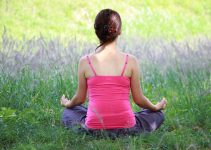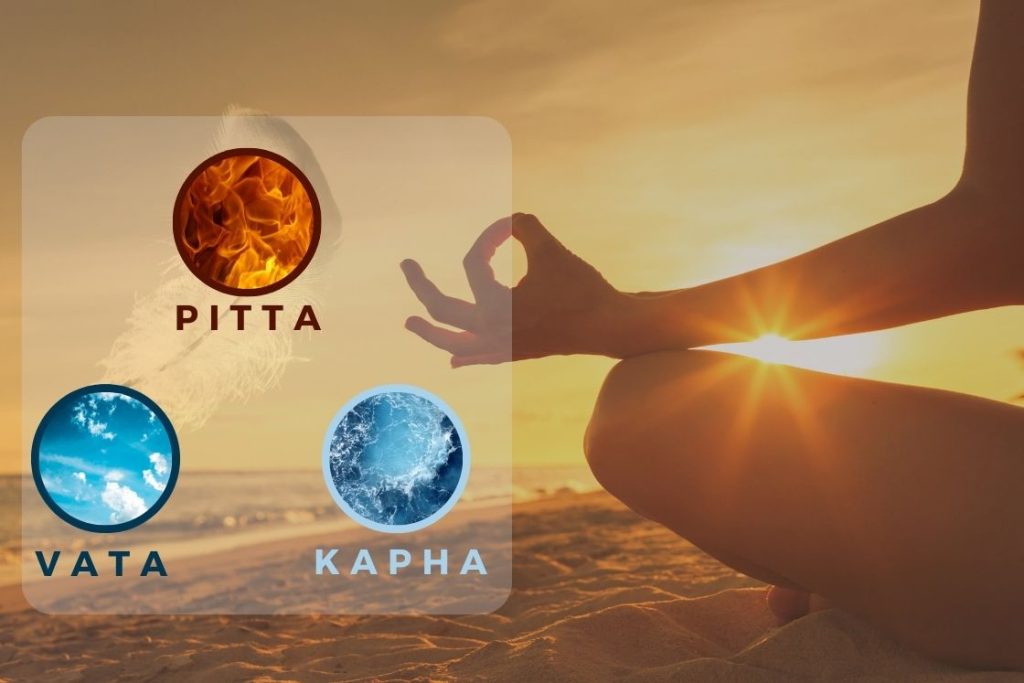
The three Tridoshas of Ayurveda—Vata, Pitta, and Kapha—are energetic forces of nature that serve as useful guides for understanding both our body-mind and the outside world.
Our physiology depends on Vata, Pitta, and Kapha, each of which has a unique set of physiological functions. These three Doshas are connected to the complete Ayurvedic healing system.
Every individual is supposed to have a particular proportion of each dosha, with one dominating the others. The Ayurvedic constitution of a person is thought to be defined by their particular vata, kapha, and pitta ratio, which serves as an indicator of achieving optimum wellness.
Physical and psychological problems can result from an out-of-balance dosha.
Also Read: 7 Reasons To Know Your Ayurvedic Body Type
An Ayurveda practitioner can assist you in making decisions from your diet to meditation practices, that will improve your health by keeping your doshas balanced.
Meditation not only helps calm the mind but also activates various glands and nerves that help in better function of your body organs as well. It is a way to complement the techniques you are following to balance your dosha.
When deciding on the meditation to perform, you should also consider your dominant dosha or the dosha that is vitiated.
In this article, we will list some meditation techniques based on the particular dosha.
Balancing Doshas Through Meditation
Since each dosha has a distinct quality or characteristic, it is essential to determine which meditation technique can counter the imbalance symptoms of a dosha. For example, a vata person has a hyper-mobile quality thus they might need a calming meditation technique like Guided Visualization. On the other hand, a kapha personality is highly prone to sleep so for them it is essential that their mind remains alert even during meditation.
Keeping track of these small nuances will prove to be extremely helpful in building a regime where you can incorporate meditation techniques suitable for your doshas.
Let us see each dosha individual along with the meditation technique that is helpful for them.
Meditation for Vata Dosha
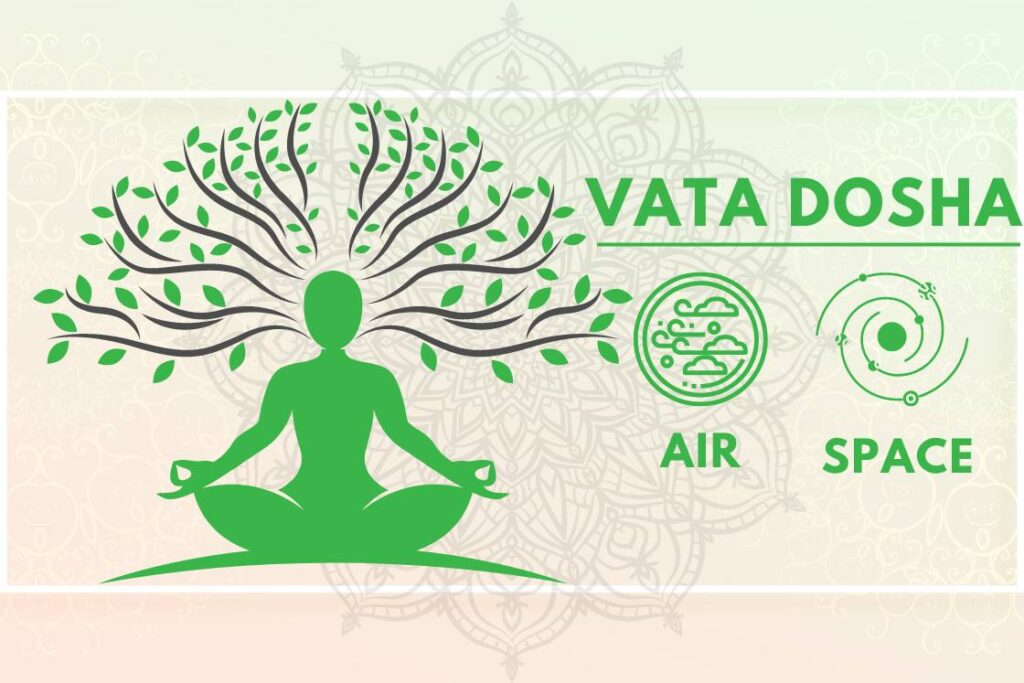
Vata is ether/space and air combined, making it brittle, bright, mobile, dry, and subtle. It is also light, sharp, harsh, and rough.
A vata constitution makes a person highly prone to hyperactivity, unpredictable moods, and behaviours, loss of routine, less sleep, continual movement, worry, fear, and stress.
Vata must engage in some form of gentle mental activity that supports grounding and tranquillity to lessen these effects.
Also Read: Physical and Mental Characteristics of Vata Individuals
Meditation that includes concentrating on an object will be useful for Vata individuals because they have short attention spans and become restless. Any meditation technique that enhances mental clarity reduces stress and mental turmoil, and promotes inner calm is beneficial for Vata dosha.
For meditation, find a location where you feel comfortable and relaxed will few external disturbances to encourage your meditation experience.
Some meditation techniques for Vata dosha are:
1. Guided Visualization
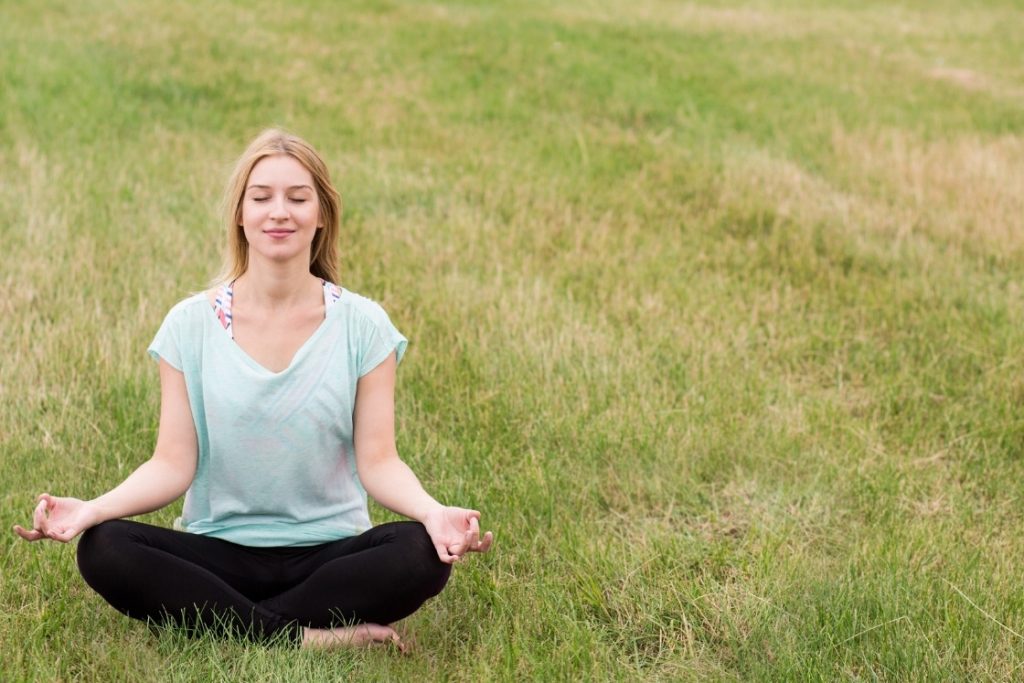
In guided visualization meditation, you typically listen to an audio of an individual guiding you through the meditation practice.
Since vata people have a low attention span, they might not be able to sit by themselves for meditation for an extended duration. Guided visualization meditation is one of the excellent meditation techniques to keep them centred and alert.
When practising guided visualization, you will hear a voice guiding you through a green meadow or a beachside. Their main aim is to invoke a feeling of calm and peace to settle the mind and body.
Guided visualization meditation sessions are typically 30-45 minutes long where you can close your eyes and sit in peace as the soft and soothing voice weaves you through a peaceful environment. You can even practice guided visualization before sleep as relaxing your mind will help you get quality sleep.
2. Deep Breathing Meditation
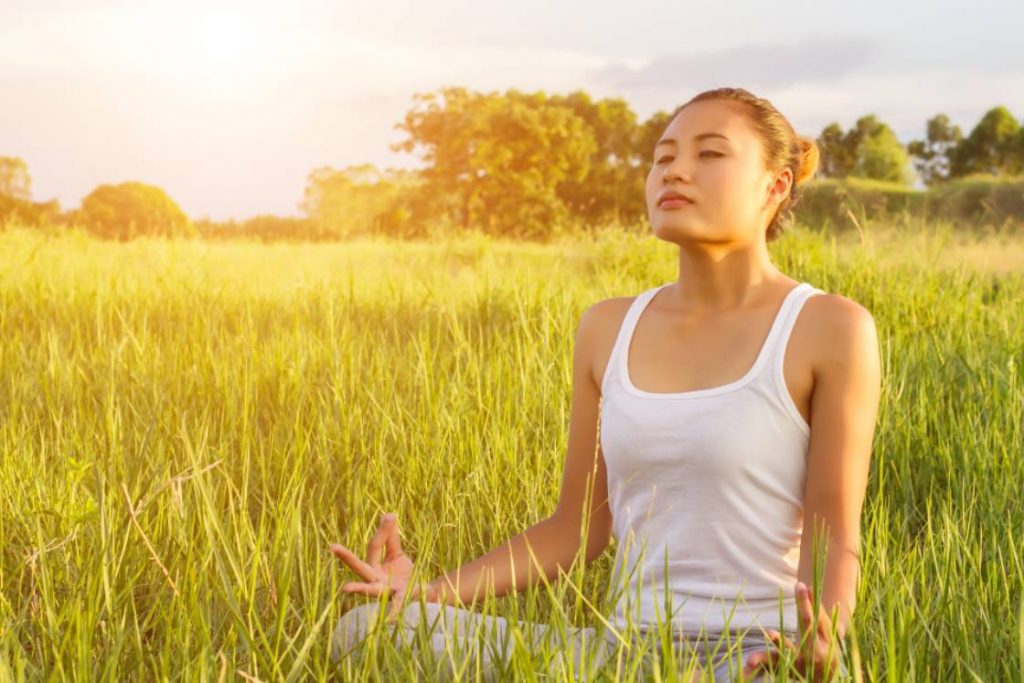
Deep breathing is known to be the best technique to calm the mind when it is agitated, anxious, or stressed. It activates the parasympathetic nervous system to trigger the rest and digest mode. It slows down the heart rate, reduces blood pressure, and improves the circulation of fresh oxygenated blood to various body organs so that they can function properly.
Deep breathing is also known as diaphragmatic breathing since you are breathing from the belly.
To practice deep breathing meditation,
- Sit in a quiet place, in a meditative position such as Padmasana or Vajrasana.
- Spend 10-15 seconds observing your regular breathing pattern. If you want, you could also place your right hand on your belly.
- Once you are relaxed, take a deep inhale from your belly. Feel the abdomen expanding as you take the deep inhalation.
- Once you feel that you cannot go any further, gently start exhaling till your belly contracts.
- Make sure that the length of your inhale and exhale are the same, i.e. if you inhale for 8 counts, your exhales should also be for 8 counts.
- Practice this method for at least 8-10 minutes in a sitting.
It is not necessary that you especially take out time to perform this meditation. You can practice it anytime you feel stressed or have tension.
Performing it before your bedtime will also aid in a peaceful and restful sleep.
3. Chanting mantras
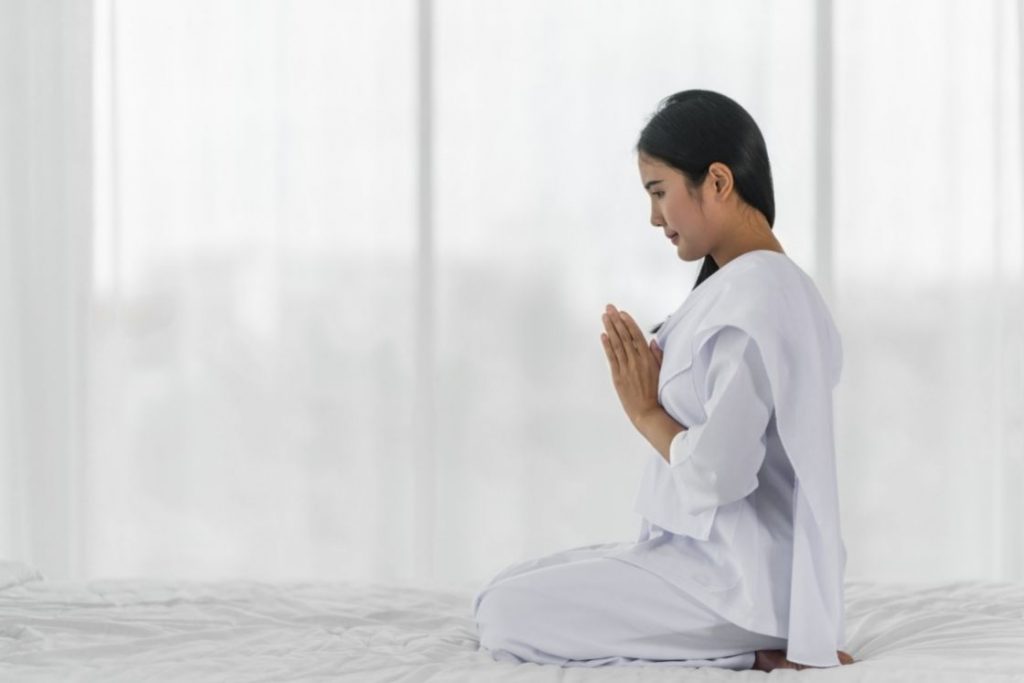
When your attention seems to be wandering, a mantra can serve as an anchor of attention to help you regain it.
Mantra chanting meditation will give Vata people something (a sound) to concentrate on. If your vata is imbalanced, during meditation reciting a mantra can help you focus more clearly and more effectively connect with your inner self. Your personality may benefit from it in ways like decreased anxiety, improved mood, and help with mental discipline.
You may also teach your mind to stay away from negative thoughts by engaging in mantra meditation.
To practice mantra meditation, you must choose a mantra that is easy to remember and recite. It can be a Vedic mantra or a mantra given to you by a guru, make sure that you are well-versed with it before starting your meditation practice.
The process of mantra meditation is the same as any other sitting meditation practice. You should start chanting your mantra once you are relaxed.
As soon as you feel that you are distracted, gently ease your mind to focus on the sound of the mantra. You may start chanting the mantra loudly to bring back attention.
Spend at least 10-15 minutes chanting the mantra in one sitting with closed eyes.
4. Yoga Nidra
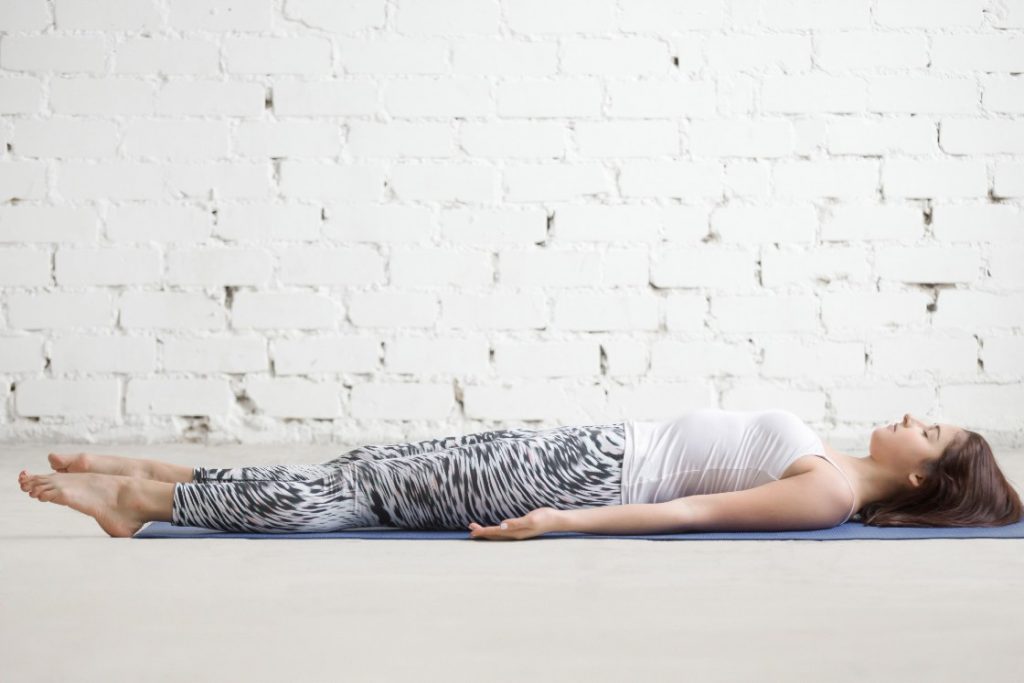
Being the hyperactive and energetic personality a vata type is, it is very common for them to suffer from insufficient sleep or insomnia. For them, yoga nidra can prove to be a boon in giving them much-needed rest.
Also referred to as yogic sleep, it is a way of experiencing the effects of restful sleep while your mind is alert. Yoga Nidra is a technique for calming down and conserving energy that is remarkably similar to falling asleep. Vata people can improve their sleeping conditions and pattern with the aid of yoga nidra.
Yoga Nidra is typically carried out with a guided meditation as it helps in establishing a calm mind and body and promoted the feeling of letting go.
To begin yoga nidra, you should lie on the floor in Savasana. Depending on the guided meditation you select, you are told to start looking for regions of your body that are tense. Breath awareness and focus are also necessary for yoga nidra to deliver the profound relaxation effect it offers.
It further induces a profound state of relaxation and helps one maintain self-control over their thoughts and feelings.
Meditation for Pitta Dosha
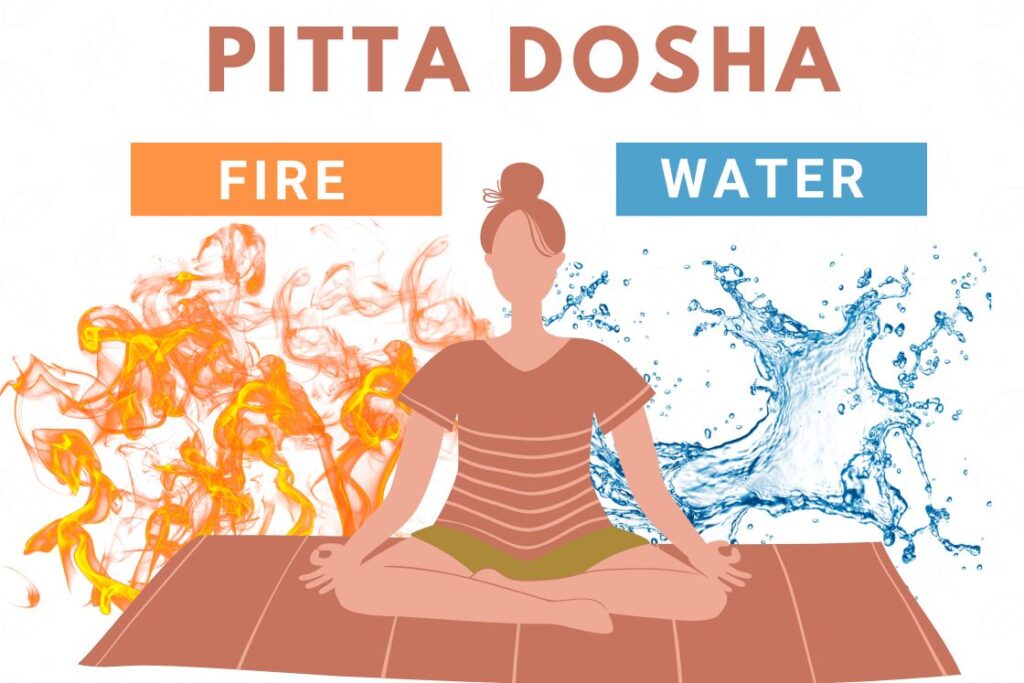
Pitta people are known for their tendency to be goal-oriented, effective leaders, maintain order, and complete tasks. Pitta dosha, with its fundamental components of fire and water, is known for being hot both physically and psychologically, giving fervour to live.
Pitta personalities love thinking back on and analyzing their past encounters. They are inherently highly introspective.
On the contrary, they also feel extreme emotions like jealousy, anger, hatred, frustration, etc. They are also prone to over-thinking, being self-critical along with agitated sleep.
Also Read: Appearance and Characteristics of Pitta Personality Dosha
Therefore, by meditation, pitta can continue to increase their self-awareness and lessen unpleasant emotions like rage, irritation, and judgment. The majority of meditation techniques are advantageous for pitta dosha since they work to maintain groundedness, calm the nervous system, and cultivate optimism.
Some beneficial practices are as follows:
1. Mindfulness Meditation
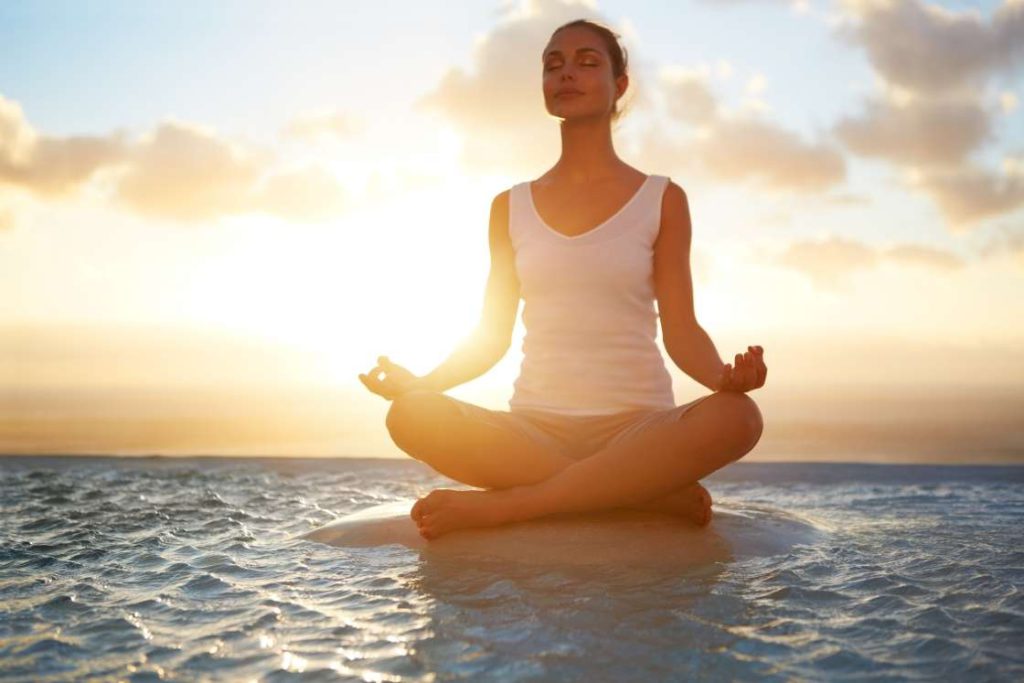
Mindfulness meditation is when you are in the moment and aware of your current surroundings. For pitta personalities, who are filled with passion and tend to lose themselves in their work, mindfulness meditation is a way to bring them back to the present and let them enjoy the subtleties of life.
Pitta will experience extreme symptoms when the hot, sharp qualities intensify as a result of life stresses or excessive heat. In such a scenario, try meditation with cooling, expansive properties.
Mindfulness meditation with a focus on breath will act as pitta’s acute focus to the breath’s delicate anchor.
- Choose a quiet area to sit so you won’t be disturbed or distracted.
- Your hands should be on your lap with the palms facing up as you sit up straight.
- Relax your face and jaw muscles and close your eyes.
- Focus on the belly to center your thoughts. Simply pay attention to how your breath naturally moves through your belly and feels without trying to control it.
- If you feel your thoughts are beginning to distract you, let them fly away and gently bring back the attention to your breath.
- Keep going for 10 to 20 minutes, till you feel your thoughts becoming quiet and peaceful.
The best part of this meditation method is that it can be done anywhere and anytime.
2. Box Breathing
Box breathing aka Sama Vritti Pranayama is yet another breathing meditation approach for pitta dosha that is very effective in stimulating the parasympathetic nervous system.
Box breathing meditation can be extremely helpful when start feeling overwhelmed as pittas have a tendency of being a workaholic. Excessive stress and anxiety may also lead to panic, which can be countered with box breathing. It will help you get back to your normal breathing pattern quickly and subside mental chaos.
Counting and deep breathing are both used in this breathing meditation.
In the box breathing technique, you inhale deeply for four counts. Next, hold your breath for 4 counts while exhaling slowly for the following 4 counts. Hold the breath for 4 counts when you exhale to finish the first cycle of breathing.
Every time, the order of inhale, hold-in, exhale and hold-out is 1:1:1:1.
3. Loving-Kindness Meditation
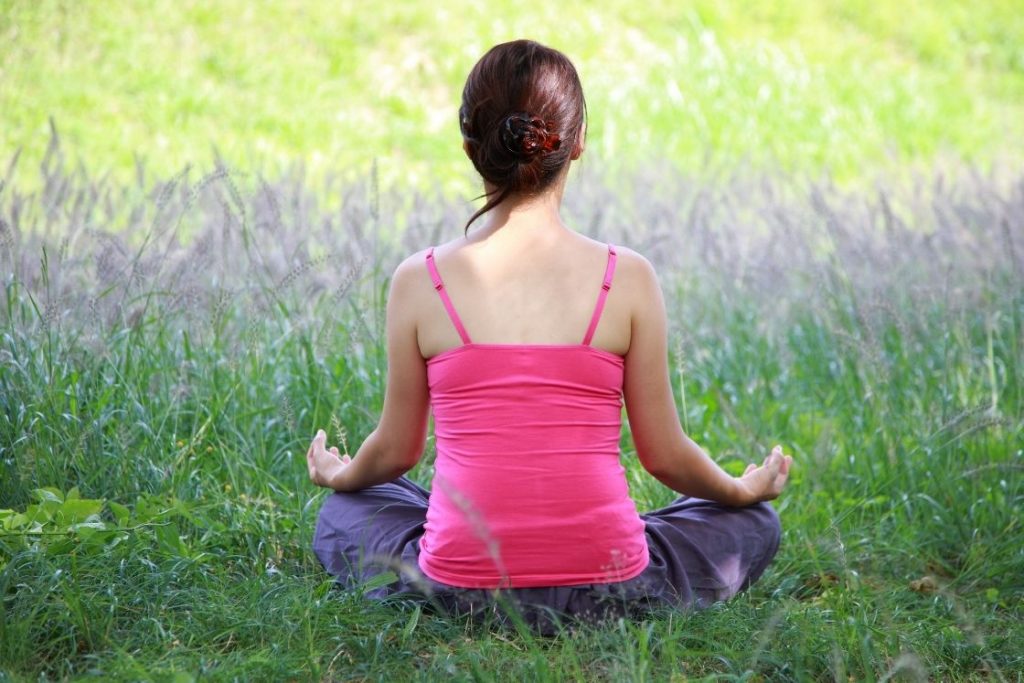
As already stated previously, pittas are competitive and experience extreme emotions and burnout. If their anger and jealousy are directed towards someone, it may prove to be harmful to both persons.
Loving and kindness meditation is an excellent way to not only feel and send love and kindness to other people but also to oneself.
- You begin this practice by sitting in a quiet and comfortable space, free from disturbances.
- Spend some time to settle your mind by focusing on your breathing.
- Now imagine or visualize a person, whether one you care about or somebody with whom you are at odds, and extend to them your love, kindness, and compassion.
The intensity of the practice increases steadily as one concentrates on oneself, then on others, enemies, and eventually the entire universe. Mentally repeating positive thoughts or emotions to yourself, someone else, or a group of people is also a part of it.
Through the calming, uplifting vibrations of unconditional, kind love, the practitioner extends love, kindness, and goodwill toward all beings.
4. Japa Meditation
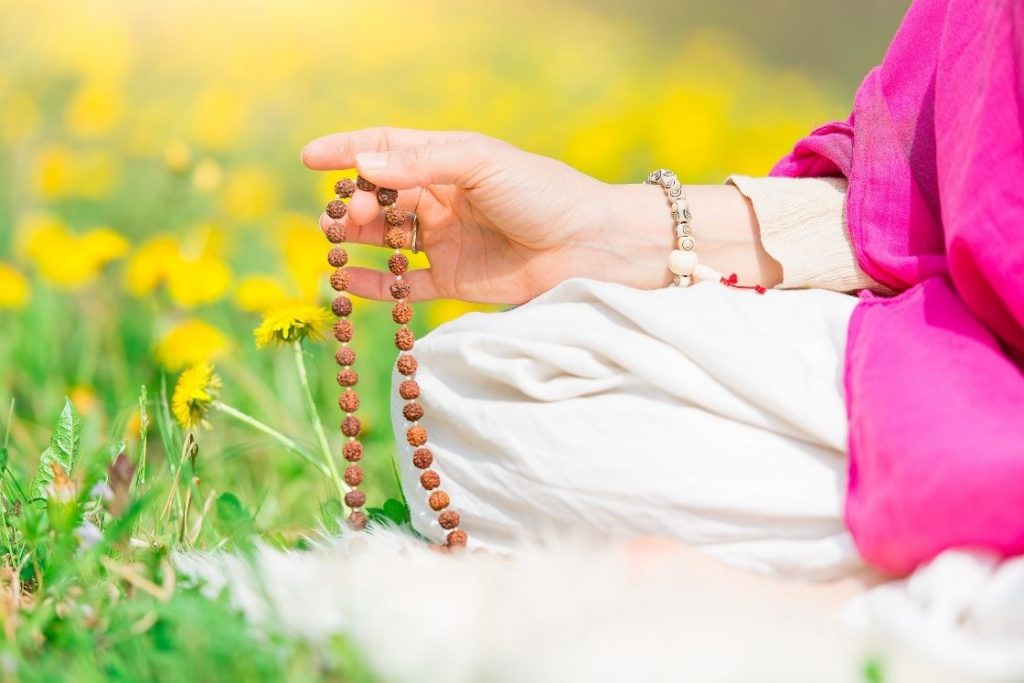
Pitta individuals have a highly competitive nature. Even the act of meditation can be taken as a challenge, making it an activity that needs to be checked off from the list. They may be compiling a list of chores that need to be completed or a checklist of things to be done the next day while sitting for meditation with their eyes closed.
Japa meditation will assist in taking away the pitta mind from such thoughts and center them in the meditation practice.
In japa meditation, you meditate on a mantra by counting the breaths on a garland or mala made with crystal or gemstone beads.
Japa meditation will assist in clearing the mind of unclean or unfavorable thoughts. Additionally, it develops a pattern of thinking that is constructive and that can assist you in overcoming negativity.
- Choose an area that is clean and peaceful where you won’t be bothered.
- Sit on a yoga mat or any cotton mat to prevent energy loss.
- To sit for longer periods, find a comfortable position to sit in, such as Sukhasana (Easy Pose), Padmasana (Lotus Pose), or any other pose you have mastered.
- The japa mala must be held in the right hand. The middle finger should be used to loop the mala. No use should be made of the index finger.
- You should have already chosen a mantra before sitting for japa meditation. It should be a mantra that is easy to recite, resonated the most with you, and can be easily remembered.
- Then, begin mentally repeating your mantra as soon as you close your eyes. To roll the beads, use your thumb. Pull a bead toward you to indicate one count when each mantra is complete.
- Take care that your mala does not touch the ground or extend much below your navel. Use the other hand to cup it underneath the mala.
- Flip the mala and begin counting in the opposite direction once you have completed the whole circle and have reached the guru bead.
- Once the meditation is done, sit still for a while or take a few slow, deep breaths.
Meditation for Kapha Dosha
The most anchored of the three doshas is the kapha dosha. When their Ayurvedic constitution is in a state of harmony, individuals may feel tired despite their efforts to be trustworthy, calm, and emotionally balanced. When the Kapha is too powerful it needs help moving forward.
The Kapha sign is a natural at meditation and is always willing to sit still and close their eyes.
Kaphas should try to sit up straight when practising meditation due to their tendency to become lethargic and lazy. Only lie down if the meditation specifically instructs you to do so. Increase the intensity of your meditation while focusing on imagery that brings the other components to the fore.
Some of the beneficial meditation techniques for Kapha are:
1. Trataka
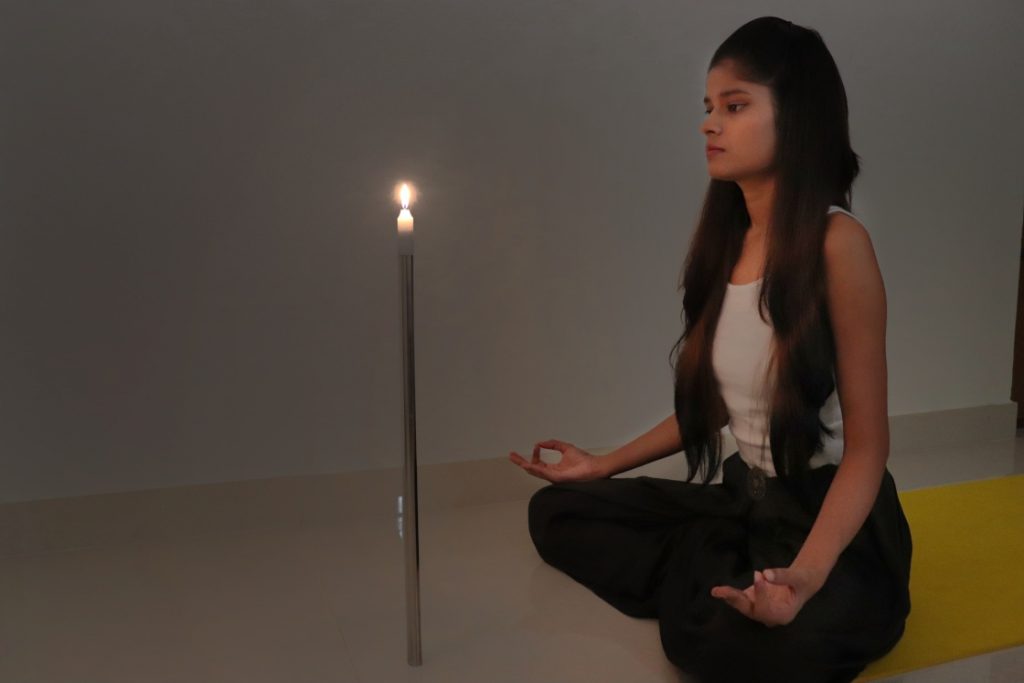
Trataka is one of the open-eyed meditation techniques that will be beneficial for kapha individuals who are highly prone to dozing off during meditation. They also lose motivation easily and need a push to work towards their goals.
It’s believed that open-eyed meditation will help you feel more connected to your environment. It also promotes mindfulness, which may be a wonderful tool for personal development and transformation, as well as boosting creativity.
You can relax your mind and find mental tranquillity by focusing on a stationary object by limiting eye movement. Both your memory and the neurological system will benefit from this.
In this meditation method, you need to keep focusing on a focal point. The most common is looking at a candle flame but can also be done with a black dot on the wall, a mandala, or a figurine of a deity.
- A burning candle should be placed 3 to 4 feet away, with the flame level with the eyes.
- With your back straight, assume a meditative position.
- Without blinking, fix your attention on the bottom of the flame, which is the most steady part.
- After some time, it’s typical for your eyes to begin to burn and moisten. At this time, you can close your eyes and focus on the flame in your mind.
- Once the mental picture disappears, open your eyes and continue for another 10-15 minutes.
2. Walking Meditation
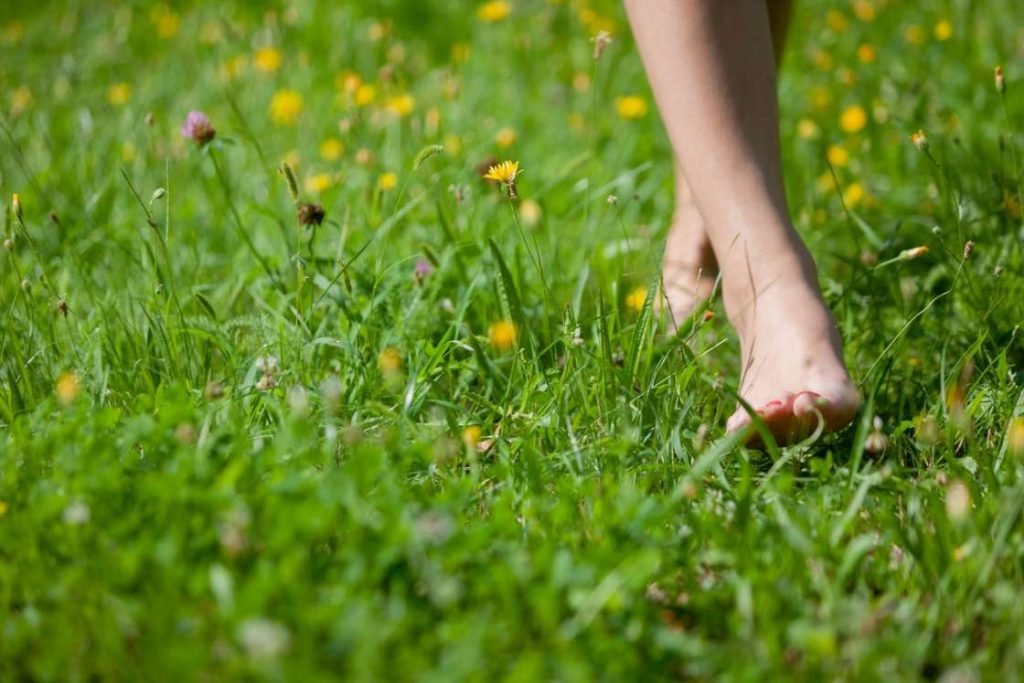
A Kapha individual benefits from any form of active meditation where they move their bodies. It generated energy and keeps their minds occupied.
Mental sluggishness, cloudy thinking, lethargy, and a lack of motivation are all signs of excessive kapha. The heavy, thick, damp features of kapha can be avoided by guaranteeing proper mobility and circulation.
Walking meditation is a great way to incorporate movement of the entire body while also promoting mental clarity and mental peace. The senses can be stimulated by walking meditation.
It’s best to walk on a natural route or in a labyrinth, but if neither of those options is accessible to you, just walk wherever – in your garden, on your terrace, or in your locality.
Breath and movements can be combined with meditation while walking.
Swinging your arms up into the air and then back down by your sides while inhaling and exhaling is an additional option.
Maintain a steady focus on the ground about 6 to 8 feet in front of you while breathing evenly in and out of your nostrils.
Conclusion
Meditation is a powerful practice for balancing Vata, Pitta, and Kapha doshas. Vata individuals can benefit from grounding techniques, Pitta individuals find relief through cooling practices like box breathing, and Kapha individuals thrive with energizing methods like trataka.
Regular meditation offers stress reduction, clarity, and self-awareness. It’s crucial to adapt techniques to individual constitutions and seek guidance for personalized support.
By tailoring practices to address the unique qualities of each dosha, individuals can experience profound benefits. Regular meditation offers stress reduction, clarity, and self-awareness. Seeking guidance and adapting techniques to individual constitutions is essential for optimal results. Embracing meditation as a holistic approach supports balance, harmony, and self-discovery.

